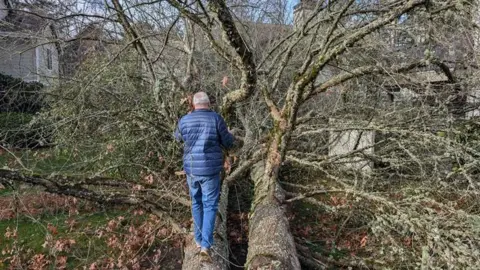Heavy rain and melting snow to come as Pacific coast storm continues
A storm off the coast of the US north-west and western Canada is pummelling the region - bringing high winds, flooding and snow to over seven million residents living in states along the Pacific Ocean.
The storm has caused widespread power outages and knocked down trees into buildings and roadways.
At least two people in the Seattle, Washington, region have died after trees fell on them in separate incidents, police say. One woman was killed while showering at home, and another was killed in a homeless encampment.
The "bomb cyclone" - as forecasters call it - has been caused by air pressure quickly dropping off the coast, which has rapidly intensified the weather system.
Winds, rain and snow expected through the week
One woman died when a tree fell on a homeless encampment in Lynwood, north of Seattle, according to a social media post from South County Fire Department.
Another woman was killed in Kirkland when a tree fell into her home while she showered, according to the Bellevue Fire Department.
Officials say that upon arriving and confirming that the woman had died, "weather conditions were so dangerous in the vicinity" that they were forced to transport the victim's husband to a safer location.
Two other people were injured in Maple Valley, south of Seattle, after a tree fell on their trailer home.

 Reuters
Reuters
Rescue crews freed two people trapped in a trailer home after a tree fell on them

 Reuters
Reuters
"It's severe out there. Trees are coming down all over the city, with multiple falling onto homes," Washington's Bellevue Fire Department wrote in a social media post during the storm.
"If you are able, head to the lowest floor you can and stay away from windows. Do not go outside if you can avoid it."
On Wednesday morning, more than 700,000 homes and businesses in Washington were without power, according to Poweroutage.us. The number shrank to around 500,000 later in the day. Around 15,000 customers were experiencing outages in California.


Schools across Washington closed on Wednesday.
Pine needles, leaves and other storm debris covered the streets as the sound of chainsaws rang out in Issaquah, a city famous for salmon hatchery in the foothills of the Cascade mountains.
One man trying to reach his sister's home in Issaquah, outside of Seattle, told BBC News on Wednesday that it looked like a bomb had hit a nearby residential courtyard, which was scattered with felled trees.
In northern California, the US Weather Prediction Center (WPC) said there was a high risk of excessive rainfall and warned of flash flooding and mudslides. The San Francisco Bay is expected to see up to 8in (20cm) of rain.
The storm has also stretched up to Canada, where wind is the primary concern and gusts of up to 100mph (160km/h) have been reported off the coast of Vancouver Island. Around 140,000 customers were without power in British Columbia, according to the British Columbia Hydro and Power Authority.
BBC Weather presenter Stav Danaos said damaging gusts would continue to ease on Wednesday, although conditions are expected to remain blustery along the Pacific coast from San Francisco up to Vancouver Island.
And incessant heavy rain is expected throughout Thursday and Friday along much of the coast, as a renewed "atmospheric river" of moisture from the Pacific is driven onshore.
Beyond wind, rain and snow, the storm could also bring flash flooding, rock slides and debris flows, as well as heavy mountain snow, in areas of high elevation. The storm has already led to blizzard conditions through the Cascade range of mountains, which runs through both the US and Canada.
The heavy, wet snow that has fallen on the Cascades and North Rockies will start to thaw towards the end of the week as milder air is ushered in.
This snow melt, combined with further heavy rain, is likely to lead to severe flooding in places from Northern California to Oregon, with a significant risk of landslides as the week ends.
What is a bomb cyclone?
Bomb cyclone is a term given by meteorologists to a storm that appears to intensify rapidly, with its central air pressure dropping to at least 24 millibars in 24 hours.
They are referred to as bomb cyclones due to the explosive power of these storms caused by the rapid fall in pressure.
The storm brings with it an array of weather, ranging from blizzards to severe thunderstorms to heavy precipitation.
These weather events are not unusual for this time of year.
Similar so-called atmospheric river events - when small regions of moisture travel outside tropical regions - have occurred throughout North America over the last few weeks.
But the conditions of an atmospheric river combined with a bomb cyclone can create a major weather event.

 1 month ago
8
1 month ago
8










 English (US) ·
English (US) ·